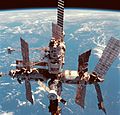Space debris facts for kids

Space debris means all the junk floating around Earth in space. Think of it like a cosmic junkyard! This includes old, broken satellites, empty parts of rockets, tiny pieces of metal, and even flecks of paint.
There's so much space junk up there that it sometimes crashes into other pieces of debris. These crashes create even more junk! Sometimes, this debris can even hit working spacecraft.
Since the very first space launch, Sputnik 1, people have been tracking objects in Earth's orbit. The NORAD keeps a list called the Space Object Catalog. This list includes everything from active satellites to all the space waste, like used rocket boosters.
Contents
What is Space Debris?
Space debris is basically anything made by humans that is no longer useful and is orbiting Earth. It can be as big as a bus or as small as a speck of dust.
Types of Space Debris
There are different kinds of space junk:
- Old Satellites: Satellites that have stopped working or run out of fuel.
- Rocket Parts: Pieces of rockets that launched satellites into space. These parts often fall off after their job is done.
- Fragments: Tiny bits created when objects crash into each other. These can be very dangerous because they travel super fast.
- Tools and Equipment: Sometimes, astronauts accidentally lose tools during spacewalks!
Why is Space Debris a Problem?
Space debris is a big concern for several reasons:
- Collisions: Even a tiny piece of debris can cause huge damage to a working satellite or spacecraft. This is because they travel at incredibly high speeds, often faster than a bullet!
- More Debris: When two objects crash, they break into thousands of smaller pieces. This creates even more debris, making the problem worse. This is sometimes called the Kessler Syndrome.
- Danger to Astronauts: Space junk poses a risk to astronauts on the International Space Station (ISS) or other missions.
- Future Space Travel: As the amount of debris grows, it becomes harder and more dangerous to launch new missions into space.
Tracking Space Junk
Scientists and space agencies around the world work hard to track space debris. They use powerful radars and telescopes to spot objects in orbit. This helps them predict if a piece of debris might hit a satellite or the ISS. If a collision is likely, they can sometimes move the satellite or station out of the way.
What Can We Do About It?
Solving the space debris problem is a big challenge. Here are some ideas people are working on:
- Cleaning Up: Developing ways to remove old satellites or large pieces of junk from orbit. This could involve using nets, harpoons, or even giant magnets.
- Safer Designs: Building new satellites and rockets that are designed to break up into smaller, less harmful pieces when they re-enter Earth's atmosphere.
- De-orbiting: Making sure that old satellites or rocket parts are guided back into Earth's atmosphere at the end of their lives. They would then burn up safely.
- Avoiding Collisions: Better tracking and warning systems to help spacecraft avoid hitting debris.
Space debris is a growing problem, but scientists and engineers are working hard to find solutions to keep space safe for future exploration!
Images for kids
-
A computer-generated image representing the locations, but not relative sizes, of space debris as could be seen from high Earth orbit. The two main debris fields are the ring of objects in geosynchronous Earth orbit (GEO) and the cloud of objects in low Earth orbit (LEO).
-
Baker-Nunn cameras were widely used to study space debris.
-
A drifting thermal blanket photographed in 1998 during STS-88.
-
Spent upper stage of a Delta II rocket, photographed by the XSS 10 satellite
-
A micrometeoroid left this crater on the surface of Space Shuttle Challenger's front window on STS-7.
-
Space Shuttle Discovery's lower starboard wing and Thermal Protection System tiles, photographed on STS-114 during an R-Bar Pitch Manoeuvre where astronauts examine the TPS for any damage during ascent
-
Space Shuttle Endeavour had a major impact on its radiator during STS-118. The entry hole is about 5.5 mm (0.22 in), and the exit hole is twice as large.
-
Spatial density of LEO space debris by altitude, according to 2011 a NASA report to the United Nations Office for Outer Space Affairs
See also
 In Spanish: Basura espacial para niños
In Spanish: Basura espacial para niños




















